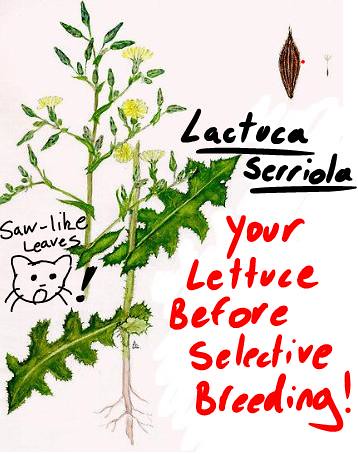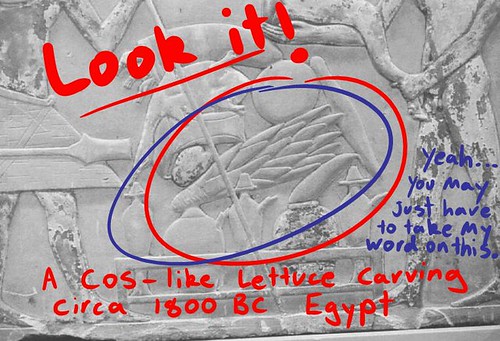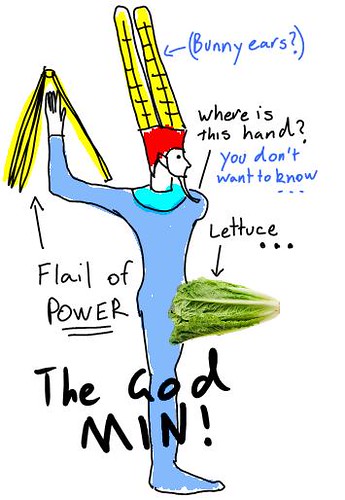First off, I want to start this blog by noting how amazing the Fertile Crescent is. It is amazingly amazing. If you are unfamiliar with the Fertile Crescent I highly suggest you go read about it, like, right now! Here, I'll even link you to its Wikipedia page [link] ... Done? Good.
I also suggest you go read/watch 'Guns Germs and Steel', but I'm not about to wait around patiently for you to do that.
It also makes me want to design an Age of Empires scenario where you can only win if you randomly happen to begin game play in the Fertile Crescent.


The cultivated lettuce we know and love today (Lactuca sativa*) has been selectively breed from Lactuca serriola*, but other species also contributed to the gene pool. The only common ground shared by all these ancestors is found in the Fertile Crescent, specifically between the Tigris and Euphrates Rivers. It spread from here to Egypt, where it has been depicted in tomb carvings and paintings from as early as 2500 BC! From Egypt it made tracks to Greece and Rome (800BC-ish). It also headed over to China at some point during all this, because, hell why not? During this millennia-long journey different cultures selected lettuce for different traits, laying the ground work for the varieties we have today.

By the time the rest of Europe got a hold of these varieties (somewhere prior to the 15th century, yes, we have no idea when!), lettuce had been bred to such an extent that the concentrations of the compounds which earned it its 'medical plant' title were near null and void.... Wait!? Are we discussing the same lettuce here? A medical plant?! What?... Yes indeed! In ancient times lettuce was prized as an analgesic, sedative,narcotic and also by the Egyptians as an aphrodisiac - it was even highly associated with their fertility god Min!

Good old Min, god of fertility and harvest, bringer of the rain, permanently depicted as holding his erect penis and worshiped by climbing a giant pole starkers... just the type I'd naturally associate with lettuce. But it's not overly far-fetched when you consider the lettuce of the time was similar to our modern day Cos/Romaine but with a higher sap content, i.e. tall, erect and exudes milky sap from the midrib... cough... Yes, as long as you can never look at a lettuce leaf the same again we here at Roots et al. will feel we have done our job!
The concept of "plants that look like a body part are good for said body part" is rampant in medical history. E.g. until relativity recently Liverwort was thought to be treatment for ails of the liver, a principle based solely on its resemblance to the liver (bad herbalists...). This philosophy was held by people well before the "Doctrine of Signatures", as evident in ancient Egypt with their "aphrodisiac" lettuce penises.
Modern science has since banished lettuce's aphrodisiac effects to realms of myth and superstition. However, its other uses as a medical plant do seem to have some grounding. Join us here at Roots et al. next time when we travel to the 19th century for "Lettuce: Your Opium Alternative?".
_______________________________________________________________
*Here at Roots et al. we wholeheartedly believe that the best people to learn Latin from are... cats.

_______________________________________________________________
Further Reading (The first two in particular are super amazingly interesting!)
I.M. de Vries (1997) Origins and domestication of Lactuca sativa L., Genetic Resources and Crop Evolution 44: 165–174. [link]
I.M. de Vries (1997) Origins and domestication of Lactuca sativa L., Genetic Resources and Crop Evolution 44: 165–174. [link]
Harlan, J.R. (1986) Lettuce and the Sycomore: sex and romance in ancient Egypt, Economic Botany 40: 4-15. [link]
Shokeir, A.A., Hussein, M.I, (2004) Sexual life in Pharaonic Egypt: towards a urological view, International Journal of Impotence Research 16: 385-388. [link]Thomas W. Whitaker (1969) Salad for Everyone - A Look at the Lettuce Plant , Economic Botany 23: 264-264. [link]
Lindqvist, K., (1960) On the origin of cultivated lettuce. Hereditas 46: 319–350. [link]
